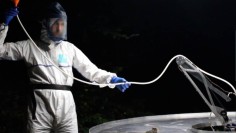OLLIEPALMER
Ant Ballet

source: vimeo
Ollie Palmer’s Ant Ballet is a three-year research project into control systems, paranoia and dancing insects, and has culminated in the world’s first ballet to exclusively feature ants. The projected insects will feature as part of the FutureEverybody Art Exhibition at the 1830 Warehouse.
Through use of a robotic arm, computer vision system and synthesised pheromone (Z9:16 Ald Hexadecenal), technology has been developed that causes a colony of ants to follow artificial trails in preference to their own natural foraging behaviour. It is described as a ‘convergent project between design, art, architecture & a handful of scientists’.
Ant Ballet is separated into four phases. Phase I (2010-2012) included thorough research into ants and control systems, synthesis of ant pheromones and testing of systems with live ants in Barcelona.
FutureEverything is displaying the documentation of Phase I, alongside a simulation of ant trails being disrupted by a model of the Ant Ballet Machine. Phases II-IV (2012-2015) will develop further technologies, chemicals and mechanisms. In 2013 the first public ant ballet performance will be presented at Pestival Sao Paolo.
Ollie Palmer is a designer. He runs Hoog and is a collaborator with Open_Sailing. He has travelled around the world, hitchhiked across Iceland, taught I.T. in the depths of the Amazon and plays with ants. He is a member of the Interactive Architecture Workshop at the Bartlett School of Architecture and is a Getty Images contributing photographer.
This project has been made possible thanks to Pestival, University College London, Universidad Autonoma Barcelona, Dupont Corian, The John Lewis Family Trust and the Zoological Society London.
FutureEverybody Art Exhibition, 1830 Warehouse, Museum of Science and Industry, Castlefield, Manchester.
.
.
.
.
.
.
.
source: olliepalmer
Ollie Palmer is an artist, designer and film-maker. His work critically questions control systems and contemporary use of technology, and takes place across installations, films and performances. Projects often include collaborations with scientists, dancers, and other people outside of his own discipline. From 2015-16 he was Pavillon artist-in-residence at the Palais de Tokyo, Paris.
He has previously exhibited a large human computer at the V&A Museum, dancing ants at London Zoo and FutureEverything Festival in Manchester, and an over-knowledgable surveillance camera at the Royal Institute of British Architects. He formerly taught at Masters level at the Bartlett School of Architecture, where he is also currently pursuing an Arts and Humanities Research Council-funded PhD by Design entitled ‘The Absurd in the Human and the Machine’. He is alumni of the Bartlett’s Interactive Architecture Lab.
Commercially, he has worked as a design consultant with clients such as BBC Worldwide, UCL and the V&A Museum, as well as leading projects for a number of other UK-based companies. In between all of the above, he has travelled around the world solo, hitchhiked across Iceland, and taught IT in the depths of the Amazon.
.
.
.
.
.
.
.
source: we-need-money-not-art
“蚂蚁芭蕾舞团”
该项目分为四个阶段,参照1974年的科幻电影Phase IV。在电影中,科学家困惑于蚂蚁在沙漠中的复杂建筑设计,蚁群经历的飞速进化成为了一个神秘的宇宙事件。
“蚂蚁芭蕾舞团”(2010-1012)阶段一,已被“未来无限”展所记录,其涵盖了对蚂蚁和控制系统的研究,人工合成的蚂蚁信息素以及对巴塞罗那活体蚂蚁的系统测试。阶段二至四,(2012-2015)将会延伸至科学技术、化学制剂以及生存机制的发展上去。在2013年,第一场蚂蚁芭蕾公开表演将在圣保罗的Pestival上演。
设计师把系统测试放在巴塞罗那进行,这是因为英国将阿根廷蚁视作高危入侵物种(它们也的确是)并且不允许他带入活体蚂蚁。所以你在曼彻斯特看到的是计算机模拟蚂蚁在圆桌上铺设的信息素路径,并被机械臂喷出的人造信息素所破坏。

